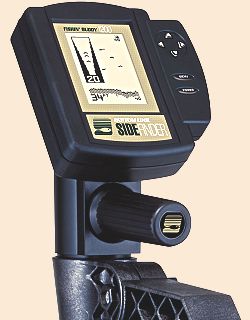|
Fish-finders? Who needs them? Not me. I sure don't
need any mumbo-jumbo electronic crap to show me how
to catch fish.
I lived by that credo for years. Other float
tubing friends bought and used different types
of depth finders - many which also detected fish - and
passed me up in their abilities at "reading" water. For
years I criticized them for depending too much on
electronics, not relying enough on their own abilities
at determining where fish "ought" to be.
Then, in 1995, my attitude towards using fish
finders on float tubes changed while fishing
the legendary Henry's Lake. I spent two months
that summer camped at the lake; Arriving in late
July and returning home about the first of October.
The fishing, for the most part, was spectacular
(most of the old-timers I fished with at the lake,
told me it was their best season ever at the Big H).
My fishing journal for that trip is replete with
descriptions of days when I caught 15 or 20 trout,
the smallest in the 2- to 3-pound range. The largest
I hooked that summer? I have no idea. I lost most
of the really big fish (over 6 pounds) to light
tippets, bad knots, heavy weed beds, and bad decisions.
I was having my best luck with very small chironomides
and scuds (16s to 20s), fished for the most part on 5X
tippets.
When you hook one of Henry's Lake's prize rainbow/cutthroat
hybrids in the six to eight pound range, fishing 5X tippets
is living pretty close to the edge. Most of the old-timers
thought I was nuts using tippets that light. I couldn't
convince them that hooking and losing lots of big fish
on 5X, was infinitely better than hooking and landing
just a few on 2X. When you get right down to it, if
I'm going to be perfectly honest, I'll admit there
were a few days when I questioned my own sanity.
Especially that afternoon when I hooked and lost
two hybrids in 20 minutes near the Stump Hole, which
I'm sure were over 10 pounds. I got a really good look
at them. They both broke water with 3-foot leaps. Since
I was alone at the time, my shouts of, not on 5X...
not on 5X, went unanswered.
But as good as the fishing was, there were still
slow days. I remember a week when the fishing in
the cliff area, on the south side of the lake, was
red hot. Then on the eighth day, I caught only one
fish. On the ninth day I got skunked. When I got
back to camp, I told my neighbor about my two bad
days. We took his boat, with two fish-finders,
across the lake and scanned the entire cliff area.
We marked only about six fish in what had been prime
producing water only a few days earlier.
"I'll show you where they are," Charlie said with a laugh.
We ran over to the mouth of Duck Creek. The fish
were stacked in the fishable pockets like cordwood,
surrounded by a couple of dozen boats. "The fish
moved over two days ago. Since you don't have a
fish-finder on your pontoon boat," he admonished me,
"you've got to pay more attention to where the boaters
are fishing."
Hell...I knew that. When the boats give up on one area,
and move to another. Follow them! They've all got
fish-finders, and they will find fish unless the
trout have all burrowed deep down in the weed beds
taking day-long siestas. While the creek holes and
springs, like Staleys, will almost always have fish
in them, big pods of trout will often move around
the lake, keying on the different hatches in different
areas.
I knew about the late July brown caddis hatch at the
mouth of Targhee Creek, and the "night caddis" that
hatches on the west side. While the damsels hatch all
over the lake, to some degree, there are certain areas
where the hatches are heaviest. This is a no-brainer.
The fish will always be where the food is most
plentiful.
My big problem that summer, was that I was fishing
from a pontoon boat, with an electric motor powered
by a standard wheel-chair battery; which has a very
short life span per charge. When these big pods of
fish were, for example, out in Bill Scheiss' Hybrid
Hole #2, or the Green Roof Hole, I couldn't get to
them (Henry's Lake is large...some 6,000 surface acres).
I was limited to a few areas on the lake where I could
row to, and return to my truck with the electric motor.
In case the wind came up...and it does fairly regularly
(and suddenly) at the big H, I wanted to always have
enough battery to get home.
When I returned to Boise that fall, I looked at all
the available fish finders, determined to pick up a
unit I could use on both my float tubes and pontoon
boats. While there were several fish finders available
that could be adapted to float tubes and kick boats,
the one model that stood out like a sore thumb, was
Bottom Line's Buddy II (now called Fishin' Buddy).
Since southwest Idaho has always been the float tubing
capital of the world, Computrol, a Meridian, Idaho
based eloctronics company, began experimenting with
portable fish finders that would work on tubes and
small boats more than a decade ago.
FISHIN' BUDDY 2255/1200

Weighing just five pounds, the Fishin' Buddy is truly
portable. Whether you travel to a remote lake, or walk
50 yards to a boat dock, this unit can go with you. It
will operate up to 40 hours on three "C" batteries.
You don't even need a boat to use the unit. Its C-clamp
mounting system lets you use it on just about any dock
and any type of boat - canoes, dinghies, john boats,
pontoon boats, rowboats and float tubes (there is an
optional bracket designed for use on float tubes). It
has a telescoping shaft for ease of transport.
The one feature that sold me on buying a Buddy II, was
its "sidefinding" capabilities. The unit's sidefinder
sends a 9-degree cone out 120 feet. Since fly fishermen
in float tubes and pontoon boats often spend a great
deal of their time fishing in water less than 10 feet
deep, this sidefinding capability is far more important
than the downward cone; whose 9-degree cone in
10 feet of water, covers a very small area. For the
angler fishing deep water, the downward cone reaches
to depths of 240 feet.
The Fishin' Buddy also has a digital readout on water
temperatures.
Although my Buddy II has performed well for me for about
8 years, I will probably be upgrading to the newer
Fishin' Buddy. My choices will be either the 2255 or
the 1200. The 2255 is the high resolution model, which
also offers a magnetic compass and circular scanning,
and sells for $270.00.
The 1200 model has all of the features my original Buddy
II had (and more), and sells for $170.00.
While my unit has performed well in showing me
where the fish are, it has also opened my eyes
about lake depths. Most of the smaller lakes
and ponds I fish have proven to be a great deal
shallower than I had once thought. Many of the
ponds I thought were 20-feet deep, have turned
out to be only 10- or 12-feet deep.
I have also learned that when trout are lying deep
in 25 or 30 foot holes, we had better use deeper
sinking lines to get our flies down where they at
least have a chance to tempt a fish. My Buddy II
has certainly reinforced my deep water trout tactics.
If I worked in a sporting goods store today, one of
the easiest products to sell would be Bottom Line's
Fishin' Buddy. I wish somebody had sold me one the
very first day they were on the market. ~ Marv
About Marv
Marv Taylor's books, Float-Tubing The West,
The Successful Angler's Journal,
More Fragments of the Puzzle, (Volume I) and More
Fragments of the Puzzle, (Volume II) are all available from
Marv. You can reach Marv by email at
marvtroutman@juno.com or by phone: 208-322-5760.
|



